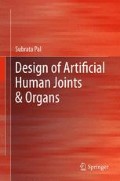Abstract
Traditionally, engineers are trained to deliver products, projects, or services to fit some specified requirements. They work to a required performance and quality, within a given time and budget. This is despite the fact that these decisions may require not only an understanding of the engineering possibilities, but also knowledge of and experience with potential environmental and social consequences.
Access this chapter
Tax calculation will be finalised at checkout
Purchases are for personal use only
For Further Details, the Following Books May Be Consulted
Shigley J, Mischke C, Brown T (2004) Standard handbook of machine design. McGraw Hill, New York
Malhotra MM, Subramaninian R (1994) Textbook in applied mechanics. New Age International, New Delhi
For static stress analysis, any text on the strength of materials or applied mechanics may be consulted
Pal S (2009) Text book of biomechanics. Viva Books, New Delhi
Author information
Authors and Affiliations
Exercises
Exercises
-
1.
How do you propose to analyze the stress and strain of a modular-type hip prosthesis? Assume a suitable dimension from any modular-type hip prosthesis. (This is described in Sect. 3.4 of this chapter.)
-
2.
Animal hip joint prostheses are in demand in these days. How one can approach the design of a (1) dog hip prosthesis and (2) a horse hip prosthesis? Consider the dynamic effect of the movement of these animals. In fact, one student, Sandip Bag, wrote a thesis on the canine hip under the guidance of this author, in 2006. (Hint: UHMWPE & Ceramic composite).
Rights and permissions
Copyright information
© 2014 Springer Science+Business Media New York
About this chapter
Cite this chapter
Pal, S. (2014). Basics of Design Process. In: Design of Artificial Human Joints & Organs. Springer, Boston, MA. https://doi.org/10.1007/978-1-4614-6255-2_3
Download citation
DOI: https://doi.org/10.1007/978-1-4614-6255-2_3
Published:
Publisher Name: Springer, Boston, MA
Print ISBN: 978-1-4614-6254-5
Online ISBN: 978-1-4614-6255-2
eBook Packages: EngineeringEngineering (R0)

